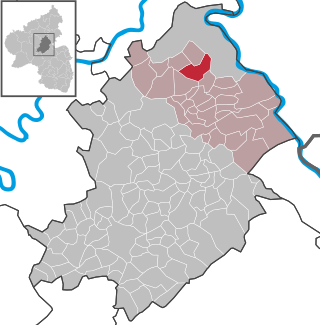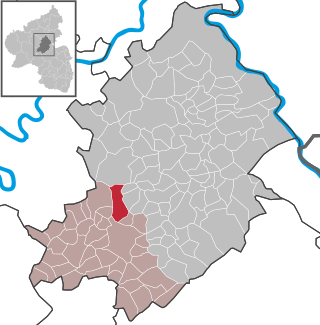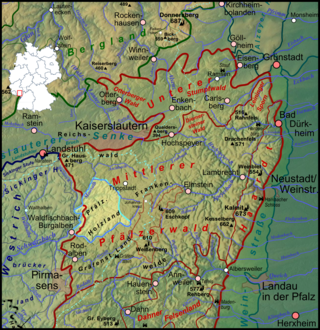Sights
Karlstal – upstream of the confluence of the Moosabl with the Aschbach is the valley of Karlstal, a largely natural and rocky narrow valley, about 4 kilometres long.
Amseldell – on the left-hand side of the Karlstal lies a formerly occupied rock cave and far above the Amseldell, a ruined site from the 19th century that formerly had a labyrinth, a firing range and a hut.
Klug’sche Mühle – The mill of Klug’sche Mühle on the Moosalb, near the lower end of the Karlstal, was converted to a restaurant after being restored. Before it transferred to the ownership of the Klug family in 1842, whose descendants still run it today, it was called the Wilensteiner Mühle.
Unterhammer – The site of Unterhammer was a former iron hammer mill and now a monument to early industrial history in the Palatinate.
Wilenstein Castle – On the right and above the Karlstal valley lie the ruins of Wilenstein Castle [ de; eo ] at a height of 400 metres. it was built in the mid-12th century. The present day Wilenstein Castle Youth Hostel (Jugendheim Burg Wilenstein) is home to a rural educational home (Schullandheim), school and youth groups.
Trippstadt Church – The baroque church in Trippstadt was built in 1744/45 on the foundations of its Gothic predecessor.
Trippstadt House – Trippstadt House (Trippstadter Schloss), designed in the baroque style from bunter sandstone from the region, was built from 1764 to 1767 to plans and under the direction of Zweibrücken architect, Sigmund Jacob Haeckher. The associated park (Schlosspark) was originally laid out along strict geometric lines in the Versailles style and was considerably larger than it is today.
Brunnenstollen – The Trippstadt Brunnenstollen [ de ] ("spring tunnel") was completed in 1767. The structure, built by driving the tunnel simultaneously from both ends, as in classical antiquity, provided the municipality with drinking water until 1965. The Brunnenstollen is a unique structure monument within Europe.
Iron Smelting Museum – The Trippstadt Iron Smelting Museum (Eisenhüttenmuseum Trippstadt) documents the boom time of the iron smelting industry, which the village experienced around the middle of the 19th century.

Lauterecken is a town in the Kusel district in Rhineland-Palatinate, Germany. It is the seat of the Verbandsgemeinde Lauterecken-Wolfstein, to which it also belongs. Lauterecken bears the nickname Veldenzstadt, after the comital family that once held sway here. It is also a state-recognized tourism resort town, and in terms of state planning is laid out as a lower centre.

Bad Münster am Stein-Ebernburg is a spa town of about 4,000 inhabitants in the Bad Kreuznach district in Rhineland-Palatinate, Germany. Since 1 July 2014, it is part of the town Bad Kreuznach. It was the seat of the former like-named Verbandsgemeinde, but not part of it. Bad Münster am Stein-Ebernburg was granted town rights on 29 April 1978 and is recognized as a mineral spring spa (Mineralheilbad) and a climatic spa. Today the "Spa" is famous for its clinics specializing in cardiological and orthopaedic rehabilitation. The many graduation towers form the largest open air inhalatorium in Europe.

Wolfstein is a town in the Kusel district in Rhineland-Palatinate, Germany. Before 1 July 2014 it was the seat of the like-named Verbandsgemeinde, since then it is part of the Verbandsgemeinde Lauterecken-Wolfstein. Wolfstein is known for its two castle ruins, Neu-Wolfstein standing over the heart of the town, and Alt-Wolfstein standing at the narrowest spot in the Lauter valley at the town's northern entrance. Wolfstein is a state-recognized recreational resort (Erholungsort).

Norheim is an Ortsgemeinde – a municipality belonging to a Verbandsgemeinde, a kind of collective municipality – in the Bad Kreuznach district in Rhineland-Palatinate, Germany. It belongs to the Verbandsgemeinde of Rüdesheim, whose seat is in the like-named town. Norheim is a state-recognized tourism community (Fremdenverkehrsort). and a winegrowing village.

Altenbamberg is an Ortsgemeinde – a municipality belonging to a Verbandsgemeinde, a kind of collective municipality – in the Bad Kreuznach district in Rhineland-Palatinate, Germany. It belongs to the Verbandsgemeinde of Bad Kreuznach, whose seat is in the like-named town.

Neef is an Ortsgemeinde – a municipality belonging to a Verbandsgemeinde, a kind of collective municipality—in the Cochem-Zell district in Rhineland-Palatinate, Germany. It belongs to the Verbandsgemeinde of Zell, whose seat is in the municipality of Zell an der Mosel. Neef is a winegrowing centre.

Roes is an Ortsgemeinde – a municipality belonging to a Verbandsgemeinde, a kind of collective municipality – in the Cochem-Zell district in Rhineland-Palatinate, Germany. It belongs to the Verbandsgemeinde of Kaisersesch.

Aschbach is an Ortsgemeinde – a municipality belonging to a Verbandsgemeinde, a kind of collective municipality – in the Kusel district in Rhineland-Palatinate, Germany. It belongs to the Verbandsgemeinde Lauterecken-Wolfstein.

Theisbergstegen is an Ortsgemeinde – a municipality belonging to a Verbandsgemeinde, a kind of collective municipality – in the Kusel district in Rhineland-Palatinate, Germany. It belongs to the Verbandsgemeinde of Kusel-Altenglan, whose seat is in Kusel.

Bickenbach is an Ortsgemeinde – a municipality belonging to a Verbandsgemeinde, a kind of collective municipality – in the Rhein-Hunsrück-Kreis (district) in Rhineland-Palatinate, Germany. It belongs to the Verbandsgemeinde Hunsrück-Mittelrhein, whose seat is in Emmelshausen.

Halsenbach is an Ortsgemeinde – a municipality belonging to a Verbandsgemeinde, a kind of collective municipality – in the Rhein-Hunsrück-Kreis (district) in Rhineland-Palatinate, Germany. It belongs to the Verbandsgemeinde Hunsrück-Mittelrhein, whose seat is in Emmelshausen.

Reckershausen is an Ortsgemeinde – a municipality belonging to a Verbandsgemeinde, a kind of collective municipality – in the Rhein-Hunsrück-Kreis (district) in Rhineland-Palatinate, Germany. It belongs to the Verbandsgemeinde of Kirchberg, whose seat is in the like-named town.

Schlierschied is an Ortsgemeinde – a municipality belonging to a Verbandsgemeinde, a kind of collective municipality – in the Rhein-Hunsrück-Kreis (district) in Rhineland-Palatinate, Germany. It belongs to the Verbandsgemeinde of Kirchberg, whose seat is in the like-named town.

The Karlstal is the valley of the Moosalb stream located near Trippstadt in the Palatine Forest in the German state of Rhineland-Palatinate. It is registered as a nature reserve - number 335 055 - under the name of Karlstalschlucht.

Holzland is the name of a region in the western part of the Palatine Forest in the German state of Rhineland-Palatinate

Johanniskreuz is a tiny hamlet in the middle of the Palatine Forest in Germany and belongs to the municipality of Trippstadt in the district of Kaiserslautern in the state of Rhineland-Palatinate.

The Waterway trail on the Moosalbe is one of seven themed walks on the subject of hydrology in the German state of Rhineland-Palatinate. The path runs for over 33 km along the Moosalbe and Hirschalbe streams through the Palatine Forest and has 23 way stations.

The Sickingen Heights form a landscape in the western part of the German state of Rhineland-Palatinate. The region was named after the family of imperial knight, Franz von Sickingen (1481–1523), because most of the area belonged to the territory of the House of Sickingen in the Middle Ages.

The Amseldell is a former park-like leisure area about two kilometres west of the German town of Trippstadt in the Palatine Forest in the state of Rhineland-Palatinate.

Trippstadt House is an 18th-century, baroque schloss or manor house in the eponymous village in the German state of Rhineland-Palatinate.
























